Radio Ghosts in Galaxy Cluster Collisions |
For 20 years now, astronomers have observed mysterious objects in some clusters of galaxies: regions of extended radio emission that are millions of light years in size but cannot be linked to any nearby galaxy. The nature of these so-called 'cluster radio relics' could now be revealed in two recent theoretical studies at the Max-Planck-Institute for Astrophysics.
The first hint towards their origin came from X-ray images of galaxy clusters containing these 'cluster radio relics'. Clusters of galaxies contain dilute and hot, X-ray emitting gas in the space between the galaxies. In most clusters this gas is symmetrically distributed about their centres. However, it was observed that clusters that host radio relics show strong deformations (see Fig. 1). These deformations indicate that violent collisions of two clusters of galaxies are taking place. These collisions, in which two clusters merge to form one bigger one, are - to our knowledge - the most energetic events in the Universe after the Big Bang. During such collisions giant shock waves are formed, in which the cluster gas is compressed and heated. Enough energy is released in these shock waves to power the emission of cluster radio relics. In several cases now, detailed investigations reveal that relics are indeed located where the presence of a shock wave can be deduced from X-ray observations. But one question remained: What is the origin of these radio relics, i.e. what are they made of?
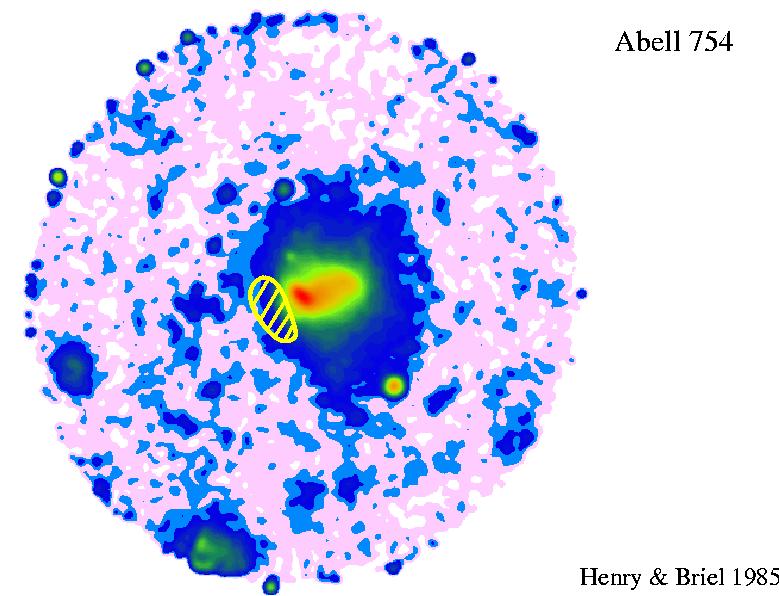
|
| Figure 1: X-ray emission from the cluster Abell 754. The elongation of the X-ray emitting gas distribution indicates that this cluster is undergoing a strong collision. At the location of the collision shock wave a cluster radio relic (marked by the yellow shaded region) could recently be detected by an international collaboration, which includes the Max-Planck Institute for Astrophysics. |
The new theoretical studies argue that old remnants of the energetic outflows from giant black holes being revived by merger shock waves. It is observationally well known that many - if not all - galaxies harbor a massive black holes in their centres. Whenever the black hole swallows galactic gas, ultra-hot radio emitting plasma is ejected along two oppositely directed jets. The jets inflate large radio plasma bubbles, which can be much larger than the galaxy in which they originate. The radio emission from the bubbles typically fades within 100 million years. The bubbles are then invisible objects, so-called 'radio ghosts'.
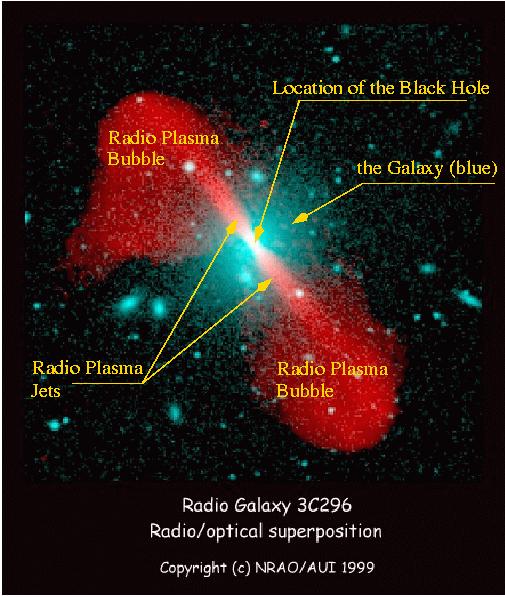
|
| Figure 2: Radio image (in red) of the radio plasma outflow from the galaxy 3C296. The optical star-light from the galaxy is shown in blue. The radio plasma bubbles are fed by fresh plasma by the two jets, which are believed to come from the direct vicinity of a very massive black hole in the centre of the galaxy. The black hole is not visible on this image. |
These radio ghosts are revived by the shock waves caused by galaxy cluster collisions and they form the cluster radio relics. In a theoretical study Torsten Enßlin (Max-Planck-Institute for Astrophysics) and Gopal-Krishna (National Center for Radioastronomy in Pune, India) have shown that even up to a billion years after the fading of the radio emission, a strong shock wave is able to revive a radio ghost and cause it to emit again. Recent 3-dimensional magneto-hydrodynamical simulations at the Max-Planck-Institute for Astrophysics by Marcus Brüggen and Torsten Enßlin show details of this process. An initially spherical radio ghost, which is filled with extremely hot and dilute radio plasma, forms a torus as it passes through a shock wave (Fig. 3).
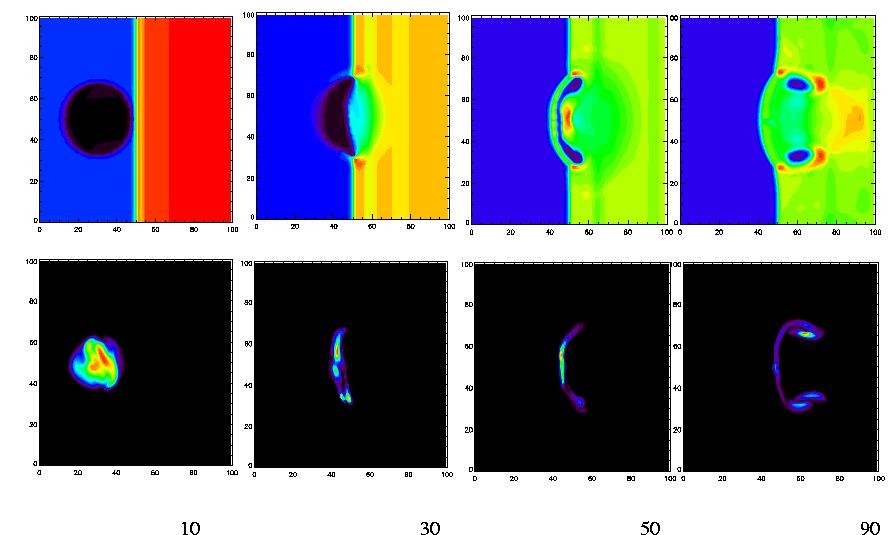
|
| Figure 3: An initially spherical radio ghost is going through an environmental shock wave. Shown are sequences of the density (top: red is high density, black is low density) and the magnetic energy density (bottom: red means strong magnetic fields, black means weak fields) in a slice through the simulation box. The 3-dimensional structure is roughly rotationally symmetric around the horizontal axis. The formation of a torus can be seen. (Click here for movies) |
Figure 4 shows high-resolution images of several cluster radio relic observations. In particular the top right relic (in the cluster Abell 85) should be compared to the simulated radio map of a shocked radio ghost in Figure 5. Low frequency radio maps show that the filamentary emission regions are indeed closed to torus-like structures, as the simulations predict. This is strong evidence in favor that indeed old radio plasma bubbles, the radio ghosts, are revived by shock waves to form the former mysterious cluster radio relics .
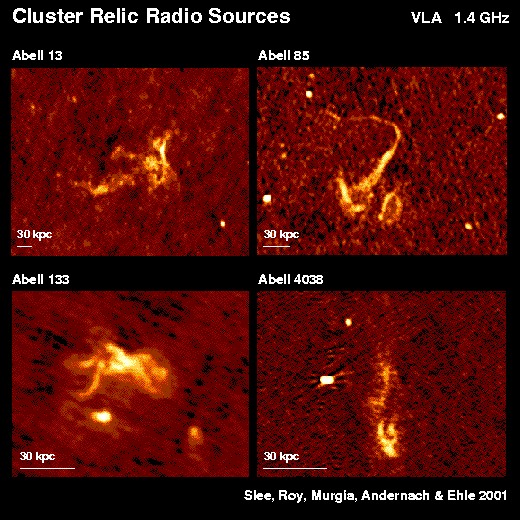
|
| Figure 4: Different high resolution 1.4 GHz images of cluster radio relics. The filamentary structures are in many cases pieces of tori, as lower frequency observations have revealed. the marked length of 30 kpc is nearly one hundred thousand lightyears. |
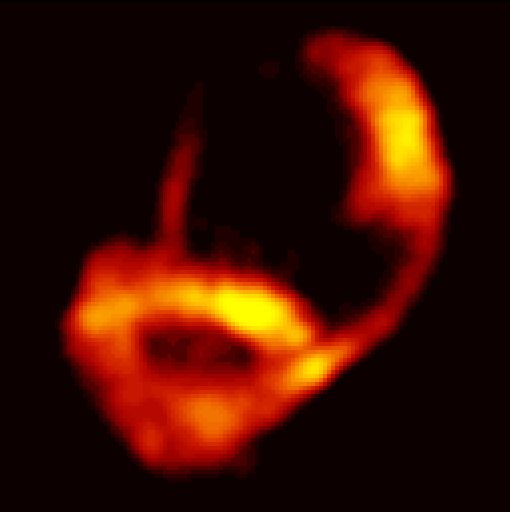
|
| Figure 5: Simulated radio relic. Please compare it to the radio emission in the cluster of galaxies Abell 85 (Fig. 3, top right image) |
| MPA-Home |